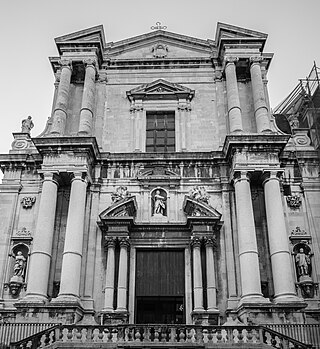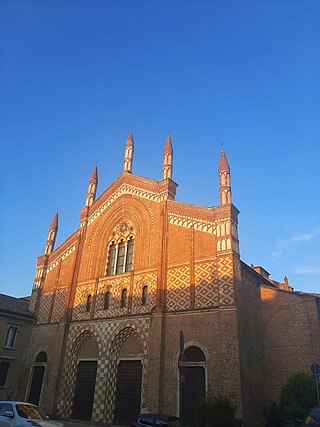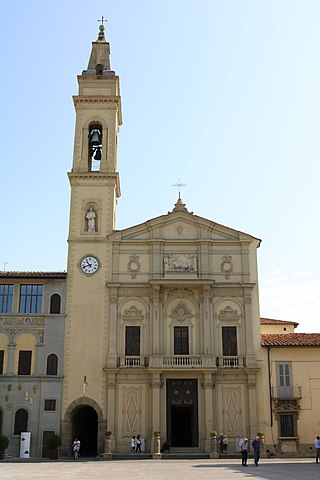
Santi Faustino e Giovita is a refurbished Romanesque-style, Roman Catholic church located on Piazza San Faustino in Viterbo, region of Lazio, Italy. The church is dedicated to the early Christian martyrs, Faustinus and Jovita.

Santi Faustino e Giovita is a refurbished Romanesque-style, Roman Catholic church located on Piazza San Faustino in Viterbo, region of Lazio, Italy. The church is dedicated to the early Christian martyrs, Faustinus and Jovita.


The neighborhood around this church began to populate in 1172 after the destruction of the town of Ferento; the neighborhood was only included within city walls by 1210. The fountain ( Fontana di San Faustino ) in front of the church was built circa 1252. [1] The church and the town's castle were granted in 1524 by the pope to the Hospitaller knights of Rhodes, recently evicted from the island by the Ottomans. The order of knights was housed in the Rocca Albornoz, located a block northeast of this church. The Grand Master Philippe Villiers de L'Isle-Adam chose the church dedicated to the martyr Faustino, for the religious functions of the Order. He brought to the church a venerated Byzantine icon of the Madonna of Constantinople. In 1527, the Knights parted from Viterbo to relocate to Malta, thus becoming Knights of Malta.
The church was nearly completely rebuilt in 1759, this time with an apsidal dome, with designs by Giuseppe Antolini. The facade now is partially plastered in between peperino stone pilasters. Further refurbishments were completed in 1901 and 1909. Between 1960 and 1962 a new marble floor and roof were added. The central portal has a rounded tympanum. On the southwest flank are wide buttresses. On the left of the central portal a marble plaque with a peperino stone frame from 1654 recalls the presence of the Order of the Knights of Rhodes. The remains of a sundial still remain visible on the left wall. The square belltower, with an onion dome, was added in 1594.
The interior has wooden choir stalls from the 18th century. The terracotta Via Crucis plaques were made in 1965 by Luigi Minciotti. The first altar on the right has a fresco dedicated to the Madonna della Luce and has a 15th-century fresco depicting Saints Bernardino of Siena and Catherine. The altarpiece is a canvas depicting the Immaculate Conception with Saints John the Evangelist and Nicholas of Bari (17th-century) attributed to Angelo Pucciatti. In a room of the former sacristy is an Assumption with Saints Charles Borromeo, Anthony Abbot, Mary Magdalene and Francis (1640) by Filippo Caparozzi, formerly in the Chapel of the Assumption located in the adjacent Monastery. In the right aisle of the presbytery is an altarpiece depicting the Madonna at the Sepulcher with the Angel of the Passion (18th-century) by Ludovico Mazzanti. In the Prada Chapel is a Massacre of the Innocents (1764) by Vincenzo Strigelli. The main altarpiece depicting the Martyrdom of Saints Faustino and Giovita in prison (1761) also by Strigelli. In the left apse is the icon of the Madonna of Constantinople. Other altarpieces (18th-century) depict San Giovanni di Patmos by Urbano Romanelli (son of Giovanni Francesco, and a Beheading of John the Baptist, by Anton Angelo Bonifazi transferred here from the church of San Giovanni Decollato. [2]

The Basilica of Saint Nicholas of Tolentino is a Roman Catholic church and minor basilica that is part of the Augustinian monastery in the hill-town of Tolentino, province of Macerata, Marche, central Italy. The church is a former cathedral of the Roman Catholic Diocese of Tolentino, suppressed in 1586.

San Francesco della Vigna is a Roman Catholic church in the Sestiere of Castello in Venice, northern Italy.

Giovanni Giacomo Barbelli was an Italian painter of the Baroque period, active in Lombardy. He was a canvas and fresco painter known for his religious and mythological scenes that decorated many churches and residences in Lombardy. He was a highly skilled draughtsman and a brilliant colorist. His work shows an inventive imagination and a thorough knowledge of perspective.

San Giovanni Evangelista is a Mannerist-style, Roman Catholic church located on Piazzale San Giovanni, located just behind the apse of the Parma Cathedral, in the historic center of Parma, northern Italy. The buildings surrounding the piazza were also part of a former Benedictine convent. The church is notable for its Correggio frescoes.

The Abbey of Santa Giustina is a 10th-century Benedictine abbey complex located in front of the Prato della Valle in central Padua, region of Veneto, Italy. Adjacent to the former monastery is the basilica church of Santa Giustina, initially built in the 6th century, but whose present form derives from a 17th-century reconstruction.

San Biagio is a Baroque architecture, Roman Catholic church, located on Via del Carmine #4 in central Modena, Italy.
The church of Santi Faustino e Giovita, also called just San Faustino, is a Romanesque-style, Roman Catholic church in the town of Rubiera, province of Reggio Emilia, region of Emilia Romagna, Italy.

San Fortunato is a Gothic- and Renaissance-style, Roman Catholic church located on Piazza Umberto I #6 in the historic center of Todi, province of Perugia, region of Umbria, Italy.

Santa Caterina d'Alessandria or Saint Catherine of Alexandria is a Roman Catholic church with a main facade on Piazza Bellini, and a lateral Western facade facing the elaborate Fontana Pretoria, in the historic quarter of Kalsa in the city of Palermo, region of Sicily, Italy. In front of the main facade, across the piazza Bellini, rise the older churches of San Cataldo and Santa Maria dell'Ammiraglio, while across Piazza Pretoria is the Theatine church of San Giuseppe and the entrance to the Quattro Canti. Refurbished over the centuries, the church retains elements and decorations from the Renaissance, Baroque, and late-Baroque (Rococo) eras. This church is distinct from the Oratorio di Santa Caterina found in the Olivella neighborhood.

San Michele e San Francesco is a renaissance-style, Roman Catholic parish church located in the Piazza SS Francesco e Michele in the town of Carmignano, province of Prato, region of Tuscany, Italy. It is best known for housing the Jacopo Pontormo altarpiece of the Visitation.

The Basilica of Santa Maria della Quercia is a Renaissance-style, Roman Catholic sanctuary church and minor basilica, about two kilometer outside of the center of Viterbo, on the road to Bagnaia, in the Region of Lazio, Italy.

Fossombrone Cathedral is a Roman Catholic cathedral dedicated to Saint Aldebrandus and Saint Augustine located in the Piazza Mazzini at the end of Corso Garibaldi in the center of the town of Fossombrone in the province of Pesaro and Urbino in the region of Marche, Italy. Formerly the cathedral of the Diocese of Fossombrone, since 1986 it has been a co-cathedral of the Diocese of Fano-Fossombrone-Cagli-Pergola.

San Giovanni is a Gothic-style, Roman Catholic church located in Appignano, province of Macerata, in the region of Marche, Italy.

Sant'Andrea a San Donnino is a Roman Catholic parish church in the San Donnino neighborhood of the town limits of Campi Bisenzio, located on the Via Pistoiese just west of Florence, in the region of Tuscany, Italy. Adjacent to the church is a small art Museum.

The Sanctuary of the Madonna del Ruscello, also known as Santa Maria del Ruscello or the Santuario di Maria Santissima del Ruscello dei Donatori di Sangue is a Baroque-style, Roman Catholic church located on Piazza A. Xerry De Caro #13 in the town of Vallerano, province of Viterbo, region of Lazio, Italy.

San Francesco Borgia is a Roman Catholic church located on Via Crociferi #7, adjacent to the former Collegio Gesuita, and parallel to San Benedetto, and about a block south on Crociferi of the church and convent of San Giuliano, in the city of Catania, region of Sicily, southern Italy. The church is mainly used for exhibits, but still holds much of the original Jesuit artwork.

The church of San Francesco of Assisi is a Catholic religious building in Pavia, Lombardy, Italy.

The Insigne Collegiata di San Lorenzo is a church in Piazza Varchi of central Montevarchi, Province of Arezzo, Tuscany, central Italy. Attached to the church is a small museum of sacred art, which includes a reconstructed chapel (tempietto) bedecked with panels by Andrea della Robbia.
The Monastero della Visitazione is a cloistered Cistercian monastic complex, including a monastery and church located on Via San Pietro in central Viterbo, region of Lazio, Italy. The complex is also referred to as the Monastero della Duchessa, due to its history. It stands across from the Istituto magistrale statale Santa Rosa di Viterbo.

Filippo Cavarozzi was an Italian Mannerist painter of the Baroque period, active mainly in Viterbo.